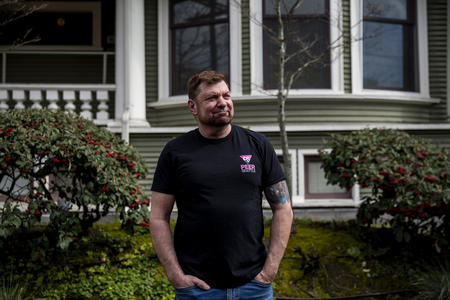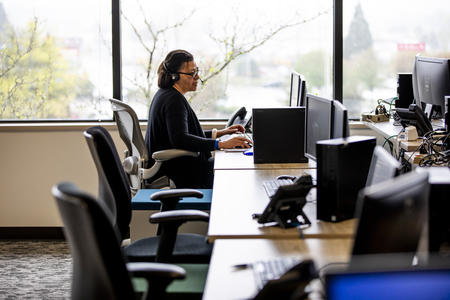“I’m not antisocial by any means but I feel like I need to make those small, totally random connections now more than ever,” says Fitch, vice president of operations at a technology consulting firm. “Even if for just a brief moment, seeing or hearing someone’s voice is reassuring.”
Seattleites like Fitch are appreciating something social scientists and psychologists have known for a while: One of the strongest predictors of human health and well-being is social connection. And with stay-at-home orders and social distancing in the past month and a half placing severe limits on who we can hug or hunker down with, researchers across the country are scrambling to study how people are coping emotionally when finances, health and general life security are put into question for so many.
One of the first such studies is a daily University of Washington survey of 500 King County residents that began March 14, in the wake of Gov. Jay Inslee’s statewide school closure announcement.
“My colleagues and I were exquisitely sensitive to the immediate dangers and dark side of social distancing,” says clinical psychologist Dr. Jonathan Kanter, director of the UW’s Center for the Science of Social Connection (CSSC) and one of the researchers on the King County study. “While necessary of course for flattening the curve, [...] we were aware that it was going to have negative mental health consequences on people. … And so we immediately wanted to try to understand that.”
While early results show promising emotional resilience among those surveyed in King County, the researchers worry that, as the crisis continues, chronic isolation will take a toll — especially as broadening medical and financial crises place stress on Seattleites’ mental health and relationships.
Studying social isolation
Kanter and his team had already been identifying how to help people improve connectedness with others and maximize relationship satisfaction, focusing on people who experience greater degrees of loneliness or who fear intimate relationships.
With that work off the table and a UW ethics panel encouraging coronavirus-related research, fifth-year graduate student Adam Kuczynski suggested setting up a daily survey that would help researchers track how coping and social connectedness evolve and inform each other over time during this unprecedented period.
“We wanted to use this moment as a sort of natural experiment, if you will, in what happens when people socially isolate,” Kuczynski says. “That’s not something that you can experimentally manipulate for ethical reasons.”
The impacts of chronic, broad social isolation and forced distancing lack modern precedent. Researchers have reviewed the impacts of quarantine from past localized epidemics, or how isolation affects people in natural disasters or war or in other states of deprivation. But the effects of prolonged isolation on so many people is new to recorded science.
“I think that's why those of us that study relationships were so eager to get studies up and running because we don't know how social isolation is going to impact people,” says Dr. Richard Slatcher, a social psychologist at the University of Georgia who studies relationships and their link to health and well-being.
The UW team’s study proved popular with the public, with the team reaching its recruitment goal in only a few days.
“We realized that we were doing something that people thought was very important,” Kanter says. “While my existing research completely came to a halt, the entire lab pivoted, and now we're busier than we've ever been.”
Participants complete a three-minute baseline survey gauging their initial mood and perspective, as well as many points of demographic data. Then for 75 days, they answer a two- to three-minute evening survey declaring how they’ve felt that day. Each survey enters them into a raffle for a $50 Amazon gift card.
The University of Georgia’s Slatcher says he’s seeing a lot of psychological studies related to coronavirus and well-being, but not in this format.
“I haven't seen anybody doing that kind of a daily survey, so that is a nice aspect of that. That makes it somewhat unique compared to other studies that are out there,” Slatcher says. He has been conducting an international survey on COVID-19’s effect on relationships every two weeks, with a goal of interviewing 6,000 to 7,000 people. The major benefit of a daily survey, he says, is the time interval. It’s difficult to recall how we’ve felt over longer periods of time.
“The closer you get to [surveying] in the moment, the closer we can get to an accurate representation of whatever it is that you're measuring,” Slatcher says. “So I think it's good that they're doing daily responses.”
The roughly 29 UW prompts consist of multiple choice, yes/no and “scale of 1 to 10” questions like:
- How much social interaction did you have today?
- I felt understood/cared for by others today.
- Approximately how much time have you spent thinking about COVID-19 today?
- I reached out to others for emotional support today.
- Have you interacted with others more or less frequently as a result of COVID-19 today?
- I used online technologies (e.g., video chat, social media, phone calls) today in an effort to stay socially connected during the COVID-19 outbreak.
- I felt a sense of solidarity with others in my community regarding COVID-19.
- COVID-19 caused conflict with my friends or family today.
With the responses, Kanter’s team can track depression, anxiety, loneliness, relationship satisfaction and other elements of mental health. Self-reported facts like gender, race and especially socioeconomic status indicators like income and changing job status help the team round out participants’ mental health risk. “A lot of people have lost their source of income, and with that a sense of meaning and purpose,” Kanter says.
The 500-person sample is “roughly equivalent to the demographics of Seattle,” Kanter says, but the team wants to see even greater representation of marginalized and minority populations. “I want to specifically focus on harder-to-reach populations, because those are the people in particular that we are worried about long-term coming out of this,” Kuczynski says.
But currently the study is at capacity and using discretionary funding, rather than grants, to keep it going. “It's a small lab and we're all working triple time to maintain all this,” Kanter says.
How King County is coping
Normally, evaluating the data now could be considered premature. But Kanter and his colleagues feel “an urgency to get our data to people who could use it as quickly as possible,” he says.
“The good news is our data suggest so far that most people in King County are coping well,” says Kanter. “Most people are adapting. Most people are showing the flexibility that's required.” The data is not yet public.
Initially, Kuczynski says respondents reported higher rates of worrying about themselves or loved ones getting the virus, having intrusive thoughts about the virus and experiencing high degrees of anxiety. Reported anxiety has decreased over time, though a blip a few days ago in the survey responses indicated higher than usual numbers for depression variables, like depressed mood or difficulty finding pleasure in things. That blip has since leveled out, the researchers say.
“In general the trend has been [on average], ‘we're adapting, we're pretty resilient, we're figuring out how to live in this crazy situation,’ ” Kuczynski says. But he cautions that there’s significant variation within the responses.
“There are a lot of people who are really struggling, [and] there are a lot of people who don’t seem to be struggling too hardcore right now,” he says. “And then there are people who jump around, for whom some days anxiety just shoots up and some days they're OK. We actually all seem to be responding differently, to the pandemic, to social distancing and to time, essentially.”
The team found use of nicotine, alcohol and marijuana changed since March 14 for respondents with a certain income level. People who make less money (earning less than $20,000) showed little change in substance use, while people who make between $20,000 and $100,000 have been drinking more alcohol.
Answers to questions that signal loneliness and depression have a mean rating of about 3 out of 10, Kuczynski says. Loneliness is not as well understood as depression. Three seems low, but Kuczynski says that’s the same rating seen in people who struggle to form relationships with others. “It's hard to know how high this is, but it seems high to us,” he says.
On April 1, Kanter and colleague Katherine Manbeck wrote an essay for The Conversation website about why he’s predicting an epidemic of depression that the country isn’t ready to handle. “We really need scalable efficient interventions that can reach a lot of people that help as many people as possible,” Kanter says.
Slatcher, Kanter and Kuczynski all note that they’re concerned about growing disparities in different groups’ ability to cope as time goes by. Marginalized groups — people of color, the poor, and homeless individuals, among others — are particularly at risk for mental health issues.
“There are subgroups of people who are struggling right now, and it's not brain science really to predict who those subgroups are,” Kanter says. Many people are also suffering from ‘complicated grief’ — an inability to process the inherent pain caused by the pandemic because of lack of time or ability. “While most people are doing well from a public health perspective, a big number aren't going to be doing well.”
Reported social interaction has increased over the course of the study. While it’s less interaction than people had in pre-pandemic life, it’s an improvement over the early days of social distancing and stay-at-home orders. “I think the story of adaptation is people are figuring out alternative and creative ways of interacting with others, of getting that sense of connection,” Kuczynski says, like video chatting.
Ted Fitch says he’s been relying on texts with friends and video messaging apps like Marco Polo to keep in touch with family — even his 80-year-old parents in Yakima use it. “I think we are super lucky to have such pervasive use of technology at this time — I think that has [been] a big part of why things may seem so normal for us,” Fitch says.
The UW team is creating a data visualization dashboard to eventually share with people in public health departments, including Public Health — Seattle & King County. (A Public Health representative confirmed in an email that it is also monitoring residents’ emotional health and well-being to inform its work.)
Since the successful launch of its King County study, Kanter’s team set up a 1,000-person-and-growing national version of the daily survey that also includes an interventional component: texting participants one science-backed coping tip a day that might help them improve their relationships during the pandemic to see if text-based mental health intervention works for this scenario.
Kanter had been preaching the value of in-person interaction over texting and even video chatting for his whole career, but now finds himself stressing that any social interaction is better than none. As more data rolls in, he and Kuczynski are feeling the impacts of social distancing themselves, and are attempting to follow some of the remote social strengthening tips they’re promoting to others.
“Never in my career has it just been so clear that there's a yearning for social connection, and it really is a fundamental human need and people are doing what people naturally do,” Kanter says. “They're reaching out, and they're doing all this beautiful stuff, finding ways to connect and singing together. [For me], a big part has just been, ‘Wow, look at us go.’ ”





